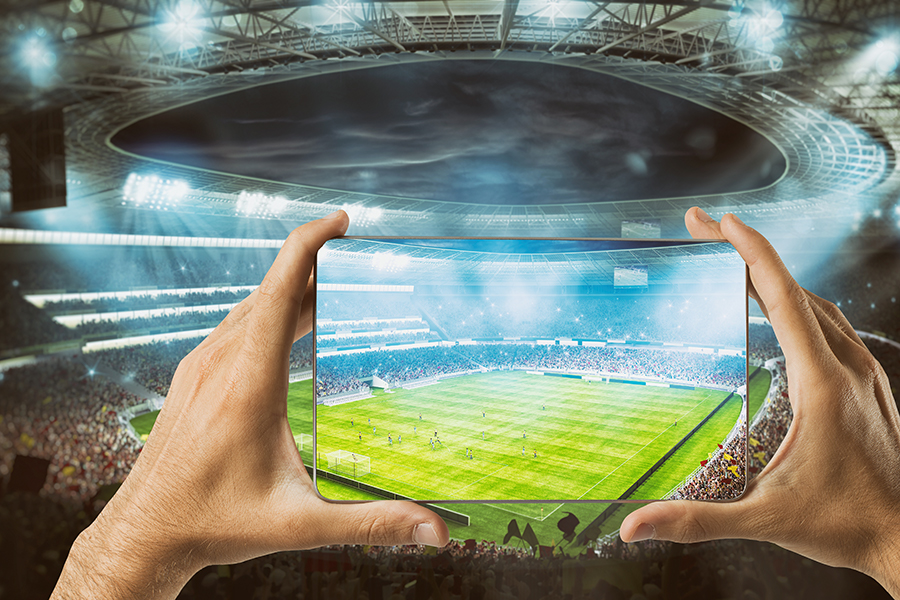5G technology: a paradigm shift hits its stride as the frontrunner in sports

Imagine being at a concert, the opening act finishing their set, and the crowd buzzing in anticipation of your favorite band coming on stage. Music starts playing, people start screaming, and a beam of light appears. You’ve seen this beam before, in old, futuristic, sci-fi movies, and think “holograms aren’t real, right?” Wrong. With 5G technology, nearly anything is possible, including hologram artists at concerts.
This actually already happened in 2019 during a concert at the first 5G-ready event venue in Brazil. And it didn’t stop there: last December, up-and-coming artist Axel Mansoor performed a live 3D augmented reality (AR) concert for 20 fans, an experience that could only be made possible using 5G.
We are on the precipice of a world powered by 5G, and soon we’ll wonder how we ever lived without it. This invisible giant often sounds like an abstract concept, so here we will explore how it can practically impact daily life and, more specifically, sports.
Bridging the gap between digital and physical fans
In an exclusive interview, Erik Ekudden, CTO of Ericsson, and Jan Söderström, Vice President of Ericsson USA, share that the low latency, high performance, and long battery life that 5G offers will radically impact the way athletes train and compete, fans watch and engage, and organizers plan and run events.
For example, having 5G in the 4K cameras makes it easier to cover any venue, as it allows for more angles to be shot - ultimately helping the fan feel more present and engaged. This is of particular importance for sports with large venues, such as golf, or of difficult access, such as in sailing, and Erik Ekudden shares with us that even in its infancy, their 5G technology trials at the Golf US Open already showed clear benefits: more camera angles, more mobility, more event coverage, and lower cost. The advanced connectivity of the 5G network eliminates the need to lay down as many cables, which reduces cost and enhances aesthetics during both streaming and live spectating.
Another example where 5G has already impacted sports is in squash where video overlays have been put on the court for players to train against. As this technology gets developed more, perhaps it could be used as part of the fan experience or integrated into the venue to give people a chance to “play against the stars.”
Laying the groundwork for device development
5G technology providers, such as Ericsson, have been working with companies to develop 5G-equipped technologies, acting as a type of incubator. Having the proper infrastructure in place is necessary before we experience the practical applications of 5G in our daily lives. This will then drive device development, because without the foundation, it’s very difficult for companies to design and develop the devices that are part of the 5G ecosystem, and Ekudden believes “the consumer devices will be what drives 5G technology to scale globally.”
By providing the network support, companies can start meeting consumers’ desire to have an experience that moves beyond just watching a smartphone. Once the infrastructure is established, 5G is much more cost-effective than the current 4G technology.
Powering smart venues
Event organizers and venues need to start actively thinking about how they will integrate 5G into their events, and venue owners need to do the same. The SoFi Stadium, located just outside Los Angeles and which will host LA2028’s opening ceremony, is one of the first venues globally to have full 5G coverage. Being at the forefront, they had to lay a lot of groundwork and learn on the job how to integrate 5G as an entire experience rather than just a feature, leading to high upfront costs. To other venues, this cost can be intimidating, especially since we have yet to see whether it will pay off as its projected to.
A big cost-saver however is that the infrastructure of 5G is consistent from venue to venue, so that features and technology can be reused rather than reinvented for each event. All consumer devices will also run on the same network, so the instead of focusing resources on building everything from the ground up, funds can be directed to other areas.
Unlocking the future of sport
By 2026, it is projected that there will be more than 3.5 billion 5G subscriptions globally. This rapid deployment will impact every industry in different ways, but in sports it will further emphasize the shift from a venue audience to streaming audience.
We are already seeing this shift, which has been made more prominent with COVID-19. Increased 5G integration into stadiums means the online fan will have new ways of interacting and engaging with their favorite sporting events and their favorite teams. 5G will help in further the development of the applications of virtual reality (VR) and AR for both athlete and fan by creating immersive experiences that bring you right into the action. The low latency and high quality will also help advance reverse streaming in sports, which has the potential to fundamentally change how sports events are produced.
5G is not going to be optional or a feature that’s just “nice to have.” It will be a necessity to remain competitive in any industry, but especially in sports where the fan is becoming more sophisticated in the experience they expect. And if you can’t provide that experience, they will go somewhere that can.
This article was produced by Purdue University for Games Flash, an internal emailer of the International Olympic Committee (IOC). As part of this collaboration, Purdue develops periodic content highlighting insights about the latest technologies sport globally. The views expressed in this article are those of the author and not necessarily those of the IOC.
Interview with Erik Ekudden and Jan Söderström
Erik Ekudden: Senior Vice President, Chief Technology Officer and Head of Group Function Technology
As Group CTO, Erik Ekudden is responsible for setting the direction of technology leadership for the Ericsson Group. Ekudden first joined Ericsson in 1993 working on mobile systems research. He has served as research area director and vice president of standardization. During his career, his team created technology and multimedia functionality that are now used in today’s smartphones worldwide. This team also conducted some of the first work on virtual and augmented reality for mobile systems. He has worked to create global mobile systems for 3G, 4G and 5G in close collaboration with customers.
He holds a Master of Science degree in Electrical Engineering from the Royal Institute of Technology in Stockholm, Sweden. Ekudden is since 2020, member of the Broadband Commission for Sustainable Development.
Jan Söderström: Vice President and Head of Technology Office Silicon Valley
Jan Söderström is Vice President and Head of Technology Office Silicon Valley at Ericsson reporting to Ericsson Group CTO. In this capacity he drives the Ericsson technology leadership work in 5G, Cloud and IoT in a collaboration with ecosystem partners in Silicon Valley. A central part in this work is the co-creation work in D-15 Labs, enabling partners and customers to develop and test new use cases on a real 5G network platform.

